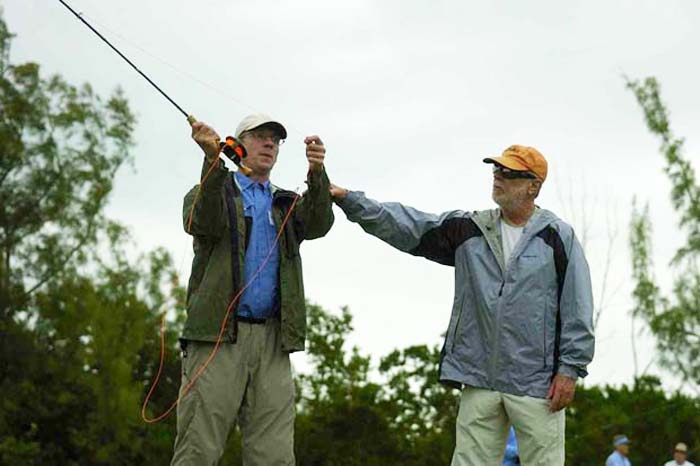Why can’t I remember how I learned to fly cast?
By Skip Clement
[dropcap]A[/dropcap] neighbor’s granddaughter watched me casting on my apartment’s cut lawn grounds. I was testing a new rod from Reilly Rod Crafters, a Chuck Kraft Signature Series 5-weight, and fly lines from RIO. A two for one review. The fly lines were RIO Skagit Trout Max shooting heads all 11-feet long – 175 grain, 200 grain, and 225 grain.
The young girl approached while I was switching reels and introduced herself. Amelia carried her grandmother’s surname. I guessed probably a high schooler. She was tall, had an athletic build, and was expressively articulate and confident. She wanted me to teach her how to fly cast. Amelia was of the manner born and used to yes.
I was a little uncomfortable – no credentials as a fly casting instructor
Fortunately, Amelia was extraordinarily coordinated and took to the idea of letting the rod do the work from the get-go. In 45 minutes she was hitting a hula hoop size ring at 50-feet with some regularity and learned introductory single-haul, the first step to double-hauling. The medium fast rod and the head-heavy line at an overloading 200 grains were made for feeling the rod load – master casting instructors on their own.
Later that day, cleaning up a story for the magazine, a file search landed on a Los Angeles Times article about the first-day experience with a hands-on fly rod. I reread the article. That evening I tried to remember what it was like for me to learn to fly cast. I couldn’t get there no matter how hard I tried to remember. Learning to cast for me started with bamboo, then glass, then, of course, graphite followed by all its incarnations to current day. Thumbing through all that in my head revealed nothing about my steps to learning to cast.
Here’s the LATimes story that provides a clue about what it’s like learning to fly cast, and why fly fishers are first defenders of conservation – clean water, protected habitat, and access:
Casting my lot with the Fly Fishers
By Kathleen Luppi / Los Angeles Times / August 12, 2016

Kathleen Luppi is the entertainment editor for TimesOC and the Daily Pilot. Before joining L.A. Times Community News, she was an award-winning journalist at the Orange County Register, where for seven years she helped cover retail, civil and criminal trials, philanthropic events and home and garden features. She received her literary journalism degree from UC Irvine.
We’re standing near a Yorba Linda pond, practicing the art of casting a fishing rod, when it finally hits me:
I have no idea what I’m doing.
Yes, I’ve just learned the basics of fly fishing from teacher Art Prangley, a vice president with the Fly Fishers of Orange County, who’s standing with Doug Jones, a past president, and avid fisherman.
They’ve taught me a lot.
Like the secrets behind how to catch trout, bass, and walleyes by floating a rod tied with an artificial fly just above the water surface.
But there’s something that makes me feel silly. And I’m not even dressed in waders.
“Pretend you answered a wall-mounted telephone and now you’re snapping the receiver back on the hook,” Prangley says, explaining the balance between power and finesse when casting.
Got it. Like what you do when hanging up on a telemarketer.
One simply cannot pick up a rod and be instantly proficient, Prangley says reassuringly, but with the proper instruction and right equipment — sunglasses are key here — it is possible to cast the line reasonably well within a few hours.
The difference between fishing and fly fishing?
It’s all in the intent. Fishing is meant to catch a lot of fish.
Fly fishing is a fascination with fooling fish into biting on a fly lure — basically an imitation of something edible that is made with animal pieces like feathers and hair — and then releasing the fish back into the water.
So what’s the point if you can’t eat what you caught?
It’s a challenge, Prangley and Jones say.
Fly fishermen say their pastime takes a certain mastery because they have to do a lot of convincing to get trout to think that what is being dangled in front of them is as tasty as a real insect.

Though fly fishing can be quite contemplative and solitary, a big social aspect is to be had as well, with groups gathering and conversing on trout streams, Prangley and Jones add. It’s mostly a male bonding experience, although a few of the club’s 150 members are women.
There is also a conservation aspect to the hobby. Basically, without clean water sources, there would be no fish.
“It takes a healthy river to make all this work,” Prangley explains.
Orange County might be an odd place to base a fly-fishing club because it doesn’t have the necessary waterways, though Prangley has tried to catch fish at the beach. He’s still working on that one.
Instead, the members have fly-fishing outings to Hot Creek Ranch in Mammoth Lakes; the Owens River, which runs through Inyo and Mono counties; and Kern River in Bakersfield.
Featured Image – Sandy Moret teaching the fine art of the double-haul to an enthusiastic attendee at Moret’s world famous Florida Keys Outfitters Fly Fishing School. A Glenn Pittard photo.


